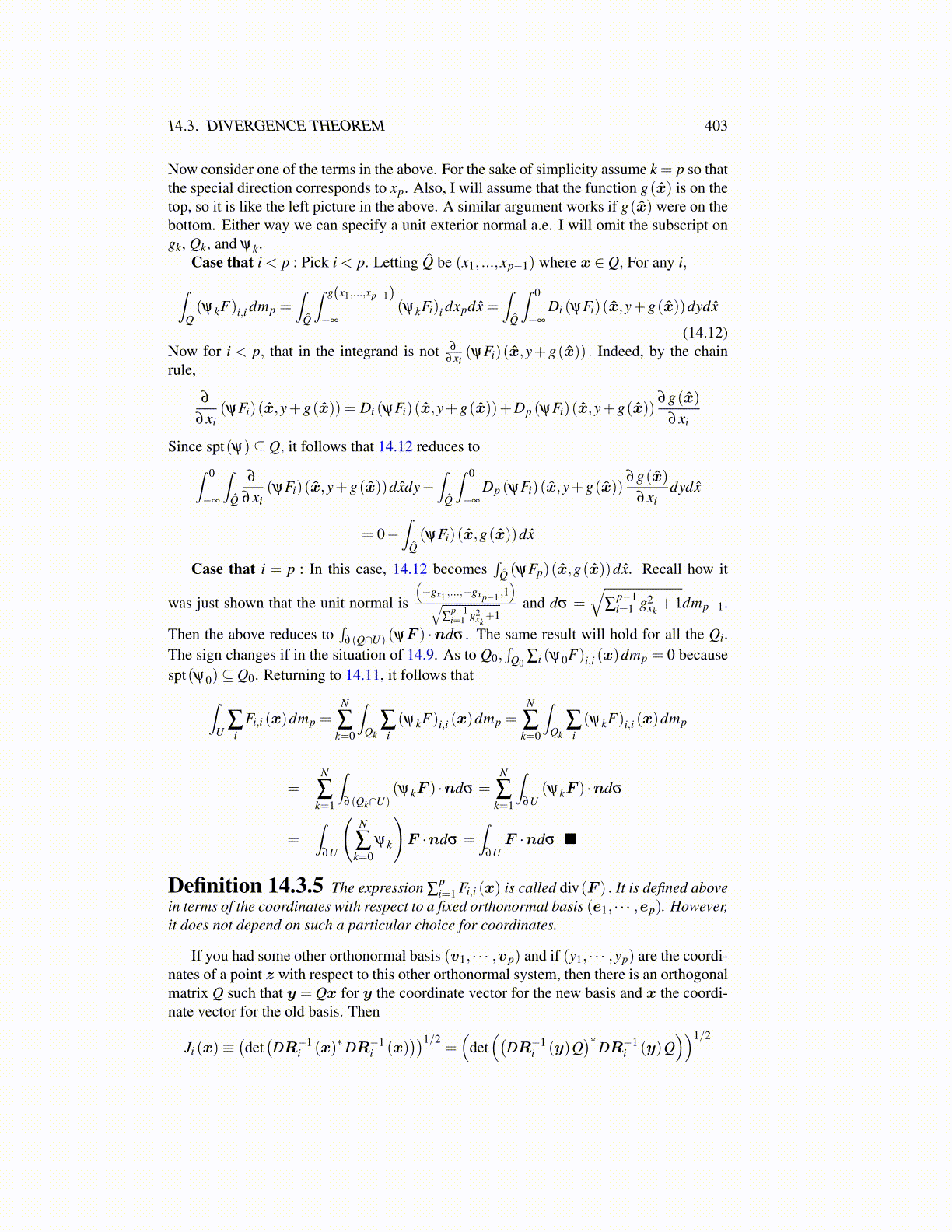
14.3. DIVERGENCE THEOREM 403
Now consider one of the terms in the above. For the sake of simplicity assume k = p so thatthe special direction corresponds to xp. Also, I will assume that the function g(x̂) is on thetop, so it is like the left picture in the above. A similar argument works if g(x̂) were on thebottom. Either way we can specify a unit exterior normal a.e. I will omit the subscript ongk, Qk, and ψk.
Case that i < p : Pick i < p. Letting Q̂ be (x1, ...,xp−1) where x ∈ Q, For any i,∫Q(ψkF)i,i dmp =
∫Q̂
∫ g(x1,...,xp−1)
−∞
(ψkFi)i dxpdx̂ =∫
Q̂
∫ 0
−∞
Di (ψFi)(x̂,y+g(x̂))dydx̂
(14.12)Now for i < p, that in the integrand is not ∂
∂xi(ψFi)(x̂,y+g(x̂)) . Indeed, by the chain
rule,
∂
∂xi(ψFi)(x̂,y+g(x̂)) = Di (ψFi)(x̂,y+g(x̂))+Dp (ψFi)(x̂,y+g(x̂))
∂g(x̂)∂xi
Since spt(ψ)⊆ Q, it follows that 14.12 reduces to∫ 0
−∞
∫Q̂
∂
∂xi(ψFi)(x̂,y+g(x̂))dx̂dy−
∫Q̂
∫ 0
−∞
Dp (ψFi)(x̂,y+g(x̂))∂g(x̂)
∂xidydx̂
= 0−∫
Q̂(ψFi)(x̂,g(x̂))dx̂
Case that i = p : In this case, 14.12 becomes∫
Q̂ (ψFp)(x̂,g(x̂))dx̂. Recall how it
was just shown that the unit normal is
(−gx1 ,...,−gxp−1 ,1
)√
∑p−1i=1 g2
xk+1
and dσ =√
∑p−1i=1 g2
xk+1dmp−1.
Then the above reduces to∫
∂ (Q∩U) (ψF ) ·ndσ . The same result will hold for all the Qi.The sign changes if in the situation of 14.9. As to Q0,
∫Q0 ∑i (ψ0F)i,i (x)dmp = 0 because
spt(ψ0)⊆ Q0. Returning to 14.11, it follows that∫U
∑i
Fi,i (x)dmp =N
∑k=0
∫Qk
∑i(ψkF)i,i (x)dmp =
N
∑k=0
∫Qk
∑i(ψkF)i,i (x)dmp
=N
∑k=1
∫∂ (Qk∩U)
(ψkF ) ·ndσ =N
∑k=1
∫∂U
(ψkF ) ·ndσ
=∫
∂U
(N
∑k=0
ψk
)F ·ndσ =
∫∂UF ·ndσ ■
Definition 14.3.5 The expression ∑pi=1 Fi,i (x) is called div(F ) . It is defined above
in terms of the coordinates with respect to a fixed orthonormal basis (e1, · · · ,ep). However,it does not depend on such a particular choice for coordinates.
If you had some other orthonormal basis (v1, · · · ,vp) and if (y1, · · · ,yp) are the coordi-nates of a point z with respect to this other orthonormal system, then there is an orthogonalmatrix Q such that y = Qx for y the coordinate vector for the new basis and x the coordi-nate vector for the old basis. Then
Ji (x)≡(det(DR−1
i (x)∗DR−1i (x)
))1/2=(
det((
DR−1i (y)Q
)∗DR−1
i (y)Q))1/2